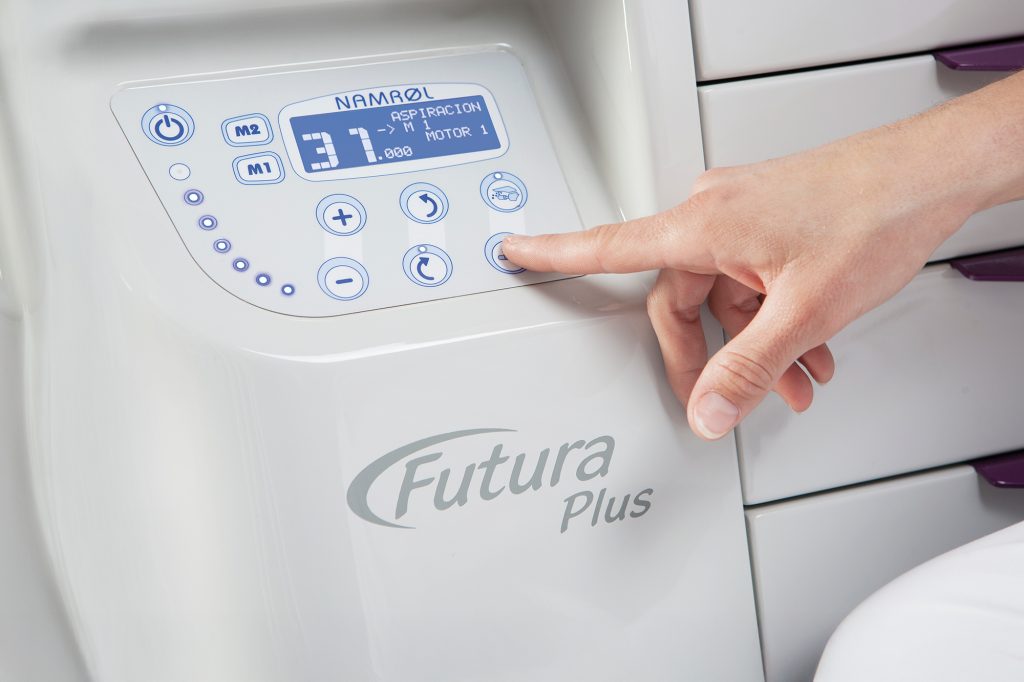A properly sized suction system not only keeps the clinic free of dust and bioaerosols; it also protects the practitioner’s airway, reduces cross-contamination, and prolongs the life of the micromotors. Below are the technical parameters, installation best practices, and preventive maintenance based on field experience with Namrol vacuum cleaners (e.g. Aerobox, Air‑S and units integrated into Duna y Futura Plus).
1. Performance variables that really matter
Recommended range | Reason | |
|---|---|---|
Suction flow rate (l/min) | ≥ 1200 l/min for keratolytic powders | Maintains visibility and prevents particle deposition on skin and instruments |
Negative pressure ( mm H₂O) | ≥ 1200 H₂O for distances up to 3 m. | Ensures constant air speed even with elbows and a partially loaded filter |
Sound level (dB A at 1 m) | < 60 dB A (according to ISO 11201) | Reduces hearing fatigue and facilitates communication with the patient |
Filtration class (EN 1822) | HEPA H13 (≥ 99.95% retention at 0.3 µm) | Captures bioaerosols, spores and gypsum residue |
Practical example: the Aerobox delivers 1350 l/min and 1300 mm H₂O at 56 dB A with a multi-layer bag + HEPA H13 pre-filter, sufficient for continuous nail milling without a visible drop in flow rate.
2. Brushless Design: Why Does It Matter in the Long Run?
Namrol brushless motors eliminate mechanical friction and carbon dust, two common sources of premature failure. Benefits:
Stable torque: Current is electronically regulated, maintaining constant flow even when the filter is at 60% load.
Lower operating temperature: + 20–25 °C lower than brushed motors, which reduces dust wetting in the bag.
Continuous duty cycle: Suitable for workdays of more than 8 hours without mandatory breaks.

3. Cascade filtration architecture
High-capacity prefilter (bag)
Material: Electrostatically charged microfiber.
Replacement: When the pressure drop reaches 40% of the initial value (approximately every 120 hours of standard clinical use)
HEPA H13
Retention ≥ 99,95 % at 0,3 µm.
Replacement: Annual or if the flow rate drops > 15 % after changing the bag.
Maintaining the sequence prevents coarse particles from saturating the HEPA filter prematurely.
4. Installation: maximize flow and minimize losses
Hose inner diameter ≥ 25 mm → loss < 4 % per linear meter.
Bend radius ≥ 3 × D → each sharp bend (+ 90°) can subtract up to 50 mm H₂O.
Total lenght < 2,5 m; if exceeded, upgrade to Ø 32 mm or install a booster.
Sealing joints: clamps with NBR gasket; a 4 % leak can reduce the effective flow rate by 15 %.
Location: Place the vacuum cleaner under the work table with anti-vibration foam; this prevents conduction of structure-borne noise and shortens the suction distance.
Ergonomic tip: combines an on/off pedal and a handle with a fine-tuning valve to adjust the suction without stopping the micromotor.
5. Preventive maintenance based on indicators
Monthly Period
- Action: Visual inspection of bag and hoses
- Control instrument: Flashlight and checklist
Quarterly Period
- Optional Action: Flow measurement (anemometer) and pressure (pressure gauge)
- Control instrument: Record in the equipment data sheet
Semiannual Period
- Action: Replace bag or filter when pressure drop (ΔP) exceeds 40%
- Control instrument: Integrated pressure switch or external pressure gauge
Annual Period
- Action: Electrical inspection and cleaning of the turbine if a bag has broken.
- Control instrument: Authorized technical service
A historical record makes it easier to detect trends and plan consumable purchases without overstocking.
6. Clinical and bio-occupational benefits
- PM2.5/PM2.5 Reduction: Lower concentrations of respirable particles, aligned with ACGIH exposure limits.
- Lower biological burden: HEPA filters retain viable bacteria; complements surface disinfection.
- Aural comfort: Vacuum cleaners <60 dBA avoid exceeding the cumulative 85 dBA established by Directive 2003/10/EC.
- Continuous workflow: Fast bag changes (<45 s) without tools, minimizing downtime.
A Namrol suction system operating at its maximum efficiency is not an accessory, but a central element of biosafety and ergonomics in the practice. By mastering the flow, pressure, and filtration parameters, the podiatrist ensures a cleaner working environment, reduces instrument wear, and improves the patient’s perception of quality.
